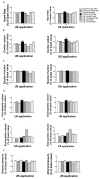The Negative Chronotropic Effect in Rat Heart Stimulated by Ultrasonic Pulses: Role of Sex and Age
- PMID: 28072471
- PMCID: PMC5359037
- DOI: 10.7863/ultra.16.02017
The Negative Chronotropic Effect in Rat Heart Stimulated by Ultrasonic Pulses: Role of Sex and Age
Abstract
Objectives: The goal of this study is to investigate the role of sex and age of the negative chronotropic effect after exposure of 3.5-MHz pulsed ultrasound (US) to the rat heart.
Methods: Forty F344 rats were exposed transthoracically to ultrasonic pulses at a duty factor of approximately 1.0% at 2.0-MPa peak rarefactional pressure amplitude. The transthoracic ultrasonic bursts were delivered consecutively in five 10-s intervals, that is, 10 s of 6-Hz pulse repetition frequency (PRF), 10 s of 5-Hz PRF, 10 s of 4-Hz PRF, 10 s of 5-Hz PRF, and 10 s of 6-Hz, for a 50-s total exposure duration. The rats were divided into 8 groups (n = 5 each): US young male, control young male, US young female, control young female, US old male, control old male, US old female, and control old female.
Results: Two-way ANOVA for repeated measures was used to compare heart rate, cardiac output, arterial pressure, and other hemodynamic values (baseline) before and after US stimulation. Sex versus age versus US interaction was detected for heart rate. Cardiac output showed an age effect, and ejection fraction showed age and US effects. The arterial pressure showed a sex effect. A negative chronotropic effect (∼30% decrease in heart rate) was observed for young female rats. An hypothesis is that the US effect is weight (menopause) dependent, because the young (premenopausal) female rats weighed approximately 40 to 60% less than other groups of rats.
Conclusions: It is likely that the ovarian hormones are responsible for different US-induced cardiac bioeffects in different ages and sexes.
Keywords: age; biological effects; chronotropic effect; heart; sex; ultrasound.
© 2017 by the American Institute of Ultrasound in Medicine.
Figures




Similar articles
-
Positive chronotropic effect caused by transthoracic ultrasound in heart of rats.JASA Express Lett. 2021 Aug;1(8):082001. doi: 10.1121/10.0005764. Epub 2021 Aug 3. JASA Express Lett. 2021. PMID: 34396365 Free PMC article.
-
Investigation of the Effects of Cardiovascular Therapeutic Ultrasound Applied in Female and Male Rats' Hearts of Different Ages.IEEE Trans Ultrason Ferroelectr Freq Control. 2022 Jan;69(1):166-180. doi: 10.1109/TUFFC.2021.3113867. Epub 2021 Dec 31. IEEE Trans Ultrason Ferroelectr Freq Control. 2022. PMID: 34543195 Free PMC article.
-
Ultrasound-induced heart rate decrease: role of the vagus nerve.IEEE Trans Ultrason Ferroelectr Freq Control. 2015 Feb;62(2):329-36. doi: 10.1109/TUFFC.2014.006755. IEEE Trans Ultrason Ferroelectr Freq Control. 2015. PMID: 25643082 Free PMC article.
-
Transthoracic cardiac ultrasonic stimulation induces a negative chronotropic effect.IEEE Trans Ultrason Ferroelectr Freq Control. 2012 Dec;59(12):2655-61. doi: 10.1109/TUFFC.2012.2506. IEEE Trans Ultrason Ferroelectr Freq Control. 2012. PMID: 23221214 Free PMC article.
-
Superthreshold behavior of ultrasound-induced lung hemorrhage in adult mice and rats: role of pulse repetition frequency and exposure duration.Ultrasound Med Biol. 2001 Feb;27(2):267-77. doi: 10.1016/s0301-5629(00)00342-2. Ultrasound Med Biol. 2001. PMID: 11316536
Cited by
-
Positive chronotropic effect caused by transthoracic ultrasound in heart of rats.JASA Express Lett. 2021 Aug;1(8):082001. doi: 10.1121/10.0005764. Epub 2021 Aug 3. JASA Express Lett. 2021. PMID: 34396365 Free PMC article.
-
Investigation of the Effects of Cardiovascular Therapeutic Ultrasound Applied in Female and Male Rats' Hearts of Different Ages.IEEE Trans Ultrason Ferroelectr Freq Control. 2022 Jan;69(1):166-180. doi: 10.1109/TUFFC.2021.3113867. Epub 2021 Dec 31. IEEE Trans Ultrason Ferroelectr Freq Control. 2022. PMID: 34543195 Free PMC article.
References
-
- Nowak B, Bjorn M. Do gender differences exist in pacemaker implantation?—results of an obligatory external quality control program. Europace. 2010;12:210–215. - PubMed
-
- Reckelhoff JF. Gender difference in the regulation of blood pressure. Hypertension. 2001;37:1199–1208. - PubMed
-
- Maric C. Sex Differences in Cardiovascular Disease and Hypertension: Involvement of the Renin-Angiotensin System. Hypertension. 2005;46:475–476. - PubMed
MeSH terms
Grants and funding
LinkOut - more resources
Full Text Sources
Other Literature Sources

